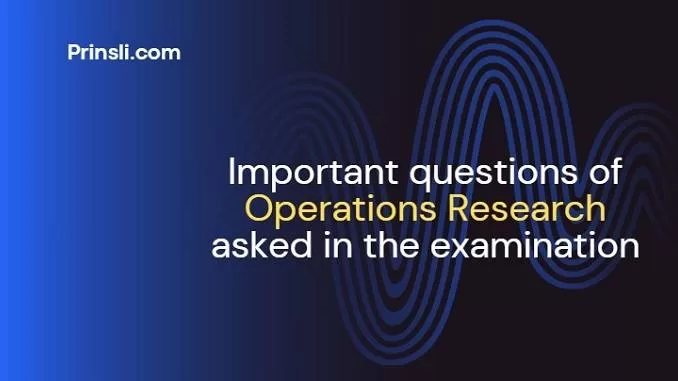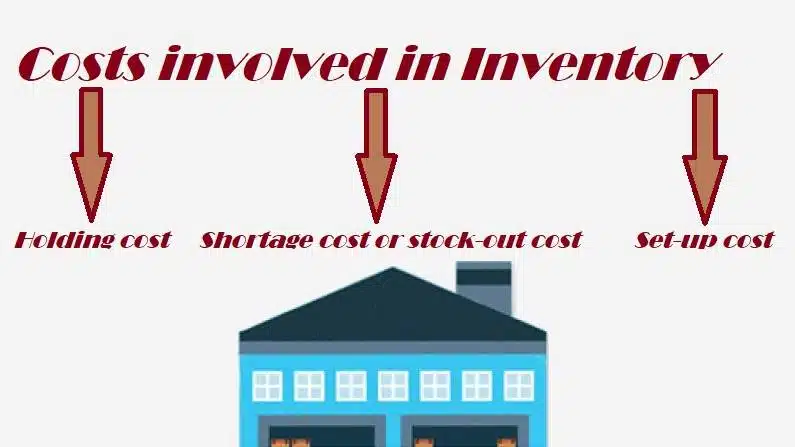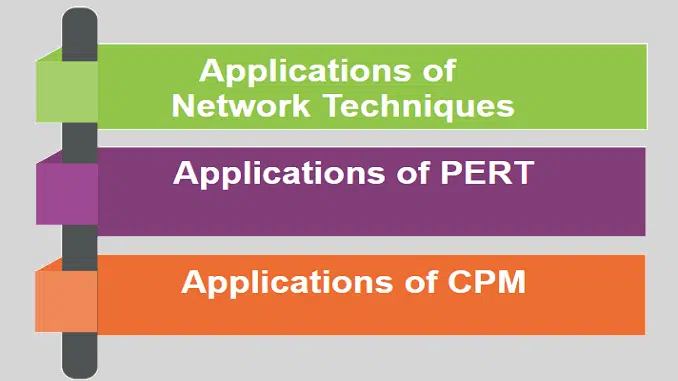
List of 100 important questions of Operations Research asked in the entrance examination for Postgraduate admission –
I can’t give you exact questions from past exams. But I can give you many example questions covering various topics in operations research. These are often included in postgraduate admission exams. Here’s a selection of 100 important questions across different areas of operations research:
Basic Concepts and Terminology of OR:
- Define Operations Research (OR) and explain its objectives.
- Discuss the role of OR in decision-making processes.
- Describe the various phases/steps involved in the Operations Research process.
- Explain the difference between deterministic and stochastic models.
- Discuss the applications of OR in real-life problems.
- Define optimization and explain its significance in OR.
- Explain the concept of an objective function in optimization.
Linear Programming (LP):
- Differentiate between linear and nonlinear programming models.
- Describe the constraints in linear programming models and their types.
- Discuss the graphical method for solving linear programming problems.
- Explain the simplex method and its steps for solving linear programming problems.
- Discuss the duality theory in linear programming.
- Formulate and solve a linear programming problem to maximize profit given constraints on resources.
- Minimize the cost of production subject to capacity constraints using the simplex method.
- Solve a transportation problem using the northwest corner method.
- Apply the dual simplex method to solve a linear programming problem.
- Determine the shadow prices for resources in a linear programming problem.
Transportation and Assignment Problems:
- Describe the transportation problem and its applications.
- Explain the North-West Corner Rule and Vogel’s Approximation Method for solving transportation problems.
- Solve a balanced transportation problem using the MODI method.
- Minimize the total cost of transportation given supply and demand constraints.
- Find an initial feasible solution for an unbalanced transportation problem.
- Discuss the concept of assignment problem and its applications.
- Solve an assignment problem using the Hungarian method.
- Formulate a transportation problem given supply and demand points.
Network Analysis:
- Define network analysis and explain its components.
- Discuss the Critical Path Method (CPM) and its significance in project management.
- Explain the Program Evaluation and Review Technique (PERT) and its advantages.
- Describe the various types of networks used in OR, such as PERT/CPM networks, transportation networks, etc.
- Identify the critical path in a project network diagram.
- Calculate the earliest start time for each activity in a project network.
- Determine the slack time for non-critical activities in a project network.
- Find the project completion time using PERT analysis.
- Perform resource leveling on a project network.
Integer Programming:
- Explain the concept of integer programming and its applications.
- Discuss the branch and bound method for solving integer programming problems.
- Formulate an integer programming problem to optimize production scheduling.
- Solve an integer programming problem using the branch and bound method.
- Minimize the number of production shifts subject to workforce constraints.
- Determine the optimal number of units to produce given integer constraints.
- Apply the cutting plane method to solve an integer programming problem.
Game Theory:
- Define game theory and explain its applications in decision-making.
- Discuss the elements of a two-player zero-sum game.
- Explain the minimax theorem and its significance in game theory.
- Describe the concept of dominance in game theory.
- Analyze a two-player zero-sum game and find the optimal mixed strategies.
- Calculate the Nash equilibrium for a non-zero-sum game.
- Solve a matrix game using the minimax theorem.
- Identify dominant strategies in a strategic game.
- Determine the payoff matrix for a given game scenario.
Queuing Theory:
- Define queuing theory and explain its applications in service systems.
- Discuss the characteristics of queuing systems and their classification.
- Explain Little’s Law and its applications in queuing theory.
- Describe the M/M/1 queuing model and its key parameters.
- Discuss the M/M/c queuing model and its significance.
- Calculate the average waiting time in an M/M/1 queuing system.
- Determine the utilization factor of a server in a queuing model.
- Analyze the steady-state probabilities of a Markovian queue.
- Find the mean queue length for a finite queueing system.
- Determine the optimal service rate for a queuing system.
Inventory Management:
- Define inventory management and explain its objectives.
- Discuss the Economic Order Quantity (EOQ) model and its assumptions.
- Explain the concept of safety stock and its role in inventory management.
- Describe the ABC analysis technique for inventory classification.
- Discuss the different types of costs associated with inventory management.
- Calculate the Economic Order Quantity (EOQ) given demand and inventory holding costs.
- Determine the reorder point for a periodic review inventory system.
- Minimize total inventory costs subject to order quantity constraints.
- Apply the Wagner-Whitin algorithm to solve a dynamic lot-sizing problem.
- Analyze the impact of lead time variability on inventory levels.
Decision Analysis:
- Define decision analysis and explain its components.
- Describe decision trees and their applications in decision analysis.
- Explain the concept of utility theory and its role in decision-making.
- Discuss the steps involved in conducting a decision analysis.
- Construct a decision tree and calculate the expected monetary value.
- Determine the maximum EMV for a decision problem with uncertainty.
- Apply Bayes’ theorem to update probabilities in a decision tree.
- Perform sensitivity analysis on a decision model with uncertain parameters.
- Calculate the regret for each decision alternative in a decision matrix.
Simulation:
- Define simulation and explain its applications in OR.
- Discuss the Monte Carlo simulation method and its steps.
- Explain the concept of random variables and probability distributions in simulation.
- Describe the discrete-event simulation technique and its advantages.
- Discuss the concept of variance reduction techniques in simulation.
- Design a Monte Carlo simulation to estimate the probability distribution of project completion time.
- Evaluate the performance of a queuing system through discrete-event simulation.
- Determine the confidence interval for a simulation output.
- Apply the central limit theorem to analyze simulation results.
- Compare the efficiency of different random number generators in a simulation model.
Nonlinear Programming:
- Define nonlinear programming and explain its applications.
- Discuss the optimality conditions for nonlinear programming problems.
- Explain the concept of convexity and its significance in nonlinear programming.
- Describe the gradient-based methods for solving nonlinear programming problems.
- Solve a constrained optimization problem using the Lagrange multiplier method.
- Apply the KKT conditions to find the local minimum of a nonlinear function.
- Minimize a nonlinear objective function subject to equality constraints.
- Determine the convexity of a given nonlinear optimization problem.
- Apply gradient-based methods to solve unconstrained nonlinear programming problems.
Supply Chain Management:
- Calculate the total cost of a supply chain network given transportation and inventory costs.
- Optimize the distribution of goods in a supply chain network.
- Determine the optimal allocation of resources in a multi-echelon supply chain.
- Analyze the bullwhip effect in a supply chain system.
- Apply the Beer Game concept to simulate supply chain dynamics.
Dynamic Programming:
- Solve a shortest path problem using the Bellman-Ford algorithm.
- Apply dynamic programming to solve the knapsack problem.
- Determine the optimal policy for a Markov decision process.
- Minimize total cost over a finite time horizon using dynamic programming.
- Calculate the value function for a dynamic programming problem.
Heuristic Optimization:
- Discuss the concept of heuristics and metaheuristics in OR.
- Apply the nearest neighbor algorithm to solve the traveling salesman problem.
- Explain the genetic algorithm and its applications in optimization problems.
- Determine the initial solution for a genetic algorithm.
- Minimize total completion time in a job shop scheduling problem using simulated annealing.
- Apply tabu search to find the optimal solution for a combinatorial optimization problem.
- Analyze the convergence behavior of a metaheuristic algorithm.
Game Theory Applications:
- Apply game theory to model and analyze strategic interactions in a competitive market.
- Determine the optimal pricing strategy for a duopoly using game theory.
- Analyze the prisoner’s dilemma and its implications for cooperation.
- Apply game theory to study bargaining and negotiation strategies.
- Evaluate the stability of cooperative agreements using game theory concepts.
Forecasting:
- Apply time series analysis techniques to forecast future demand.
- Determine the accuracy of a forecast using measures such as MAPE and MAD.
- Apply exponential smoothing to update forecasts over time.
- Analyze the seasonality and trend components in a time series dataset.
- Evaluate the performance of different forecasting models using cross-validation.
Decision Support Systems:
- Design a decision support system for inventory management.
- Implement a simulation-based decision support system for capacity planning.
- Develop a supply chain optimization model using decision support tools.
- Apply data mining techniques to extract insights from operational data.
- Evaluate the effectiveness of a decision support system in improving decision-making.
Risk Analysis:
- Perform sensitivity analysis on a financial model to assess the impact of input parameters.
- Determine the Value at Risk (VaR) for a portfolio of financial assets.
- Apply scenario analysis to evaluate the potential outcomes of a strategic decision.
- Calculate the conditional value of perfect information in a decision model.
- Analyze the risk-return tradeoff using portfolio optimization techniques.
Game Theory and Social Networks:
- Apply game theory to model interactions in social networks.
- Determine the optimal strategy for information dissemination in a social network.
- Analyze the dynamics of cooperation and defection in social dilemmas using game theory.
- Evaluate the impact of network structure on the spread of influence in social networks.
- Apply network centrality measures to identify influential nodes in a social network.
Operations Research in Healthcare:
- Design an optimization model for hospital staff scheduling.
- Apply queuing theory to analyze patient flow in a healthcare facility.
- Develop a decision support system for resource allocation in healthcare delivery.
- Evaluate the performance of healthcare facilities using data envelopment analysis.
- Apply simulation modeling to assess the impact of different healthcare policies.
Operations Research in Manufacturing:
- Design a production planning model for a manufacturing facility.
- Optimize the layout
Remember, the specific questions (important questions of operations research) asked may vary from year to year and across different universities. It’s essential to thoroughly understand the concepts, practice solving problems, and familiarize yourself with the format of past entrance exams to prepare effectively.
Copyrighted Material © 2019 - 2024 Prinsli.com - All rights reserved
All content on this website is copyrighted. It is prohibited to copy, publish or distribute the content and images of this website through any website, book, newspaper, software, videos, YouTube Channel or any other medium without written permission. You are not authorized to alter, obscure or remove any proprietary information, copyright or logo from this Website in any way. If any of these rules are violated, it will be strongly protested and legal action will be taken.




Be the first to comment